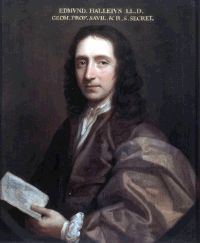

Edmond Halley FRS (sometimes "Edmund", November 8, 1656 – January 14, 1742) was an English astronomer, geophysicist, mathematician, meteorologist, and physicist.
Biography and career
Halley was born at Haggerston, London, the son of a wealthy soapboiler. As a child, he was very interested in mathematics. He studied at St Paul's School, and then from 1673 at The Queen's College, Oxford. Whilst an undergraduate he published papers on the solar system and sunspots.
On leaving Oxford, in 1676, he visited the south Atlantic island of St. Helena with the intention of studying stars from the Southern Hemisphere. He returned to England in November 1678. In the following year he published Catalogus Stellarum Australium which included details of 341 southern stars. These additions to the star map earned him comparison with Tycho Brahe. He was awarded his M.A. degree at Oxford and elected as a Fellow of the Royal Society.
In 1686 Halley published the second part of his expedition, being a paper and chart on trade winds and monsoons. In this he identified solar heating as the cause of atmospheric motions. He also established the relationship between barometric pressure and height above sea level. His charts were an important contribution to the emerging field of information visualization.
Halley married in 1682 and settled in Islington. He spent most of his time on lunar observations, but was also interested in the problems of gravity. One problem that attracted his attention was the proof of Kepler's laws of planetary motion. In August 1684 he went to Cambridge to discuss this with Isaac Newton, only to find that Newton had solved the problem but published nothing. Halley convinced him to write the Principia Mathematica Philosophiae Naturalis (1687), which was published at Halley's expense.
In 1693 he published an article on life annuities, which featured an analysis of age-at-death taken from the records of Breslau, a Polish-German town known for keeping meticulous records. This allowed the British government to sell life annuities at an appropriate price based on the age of the purchaser. Halley's work strongly influenced the development of actuarial science. The construction of the life-table for Breslau, which followed more primitive work by John Graunt, is now seen as a major event in the history of demography.
In 1690 he completed plans for a diving bell, an apparatus capable of remaining submerged for extended periods of time, and fitted with a window for the purpose of undersea exploration. In Halley's diving bell, atmosphere is replenished by sending weighted barrels of air down from the surface.
In 1698 he received a commission as captain of HMS Paramore to make extensive observations on the conditions of terrestrial magnetism. This task he accomplished in an Atlantic voyage which lasted two years, and extended from 52 degrees north to 52 degrees south. The results were published in a General Chart of the Variation of the Compass (1701). This was the first such chart to be published and the first on which isogonic, or Halleyan, lines appeared.
In November 1703 he was appointed Savilian professor of geometry at Oxford University, and received an honorary degree of doctor of laws in 1710. In 1705, applying historical astronomy methods, he published Synopsis Astronomia Cometicae, which stated his belief that the comet sightings of 1456, 1531, 1607, and 1682 related to the same comet, which he predicted would return in 1758. When it did it became generally known as Halley's Comet.
In 1716 Halley suggested a high-precision measurement of the distance between the Earth and the Sun by timing the transit of Venus. In 1718 he discovered the proper motion of the "fixed" stars by comparing his astrometric measurements with those of the Greeks.
In 1720, Halley succeeded John Flamsteed as Astronomer Royal, a position which he held until his death. He was buried at St. Margaret's Church in Lee in south-east London.
Hollow Earth
In 1692 (Philosophical Transactions of Royal Society of London), Halley put forth the idea of a hollow Earth consisting of a shell about 500 miles (800 km) thick, two inner concentric shells and an innermost core, about the diameters of the planets Venus, Mars, and Mercury. Atmospheres separate these shells, and each shell has its own magnetic poles. The spheres rotate at different speeds. Halley proposed this scheme in order to explain anomalous compass readings. He envisaged the atmosphere inside as luminous (and possibly inhabited) and speculated that escaping gas caused the Aurora Borealis[1].
Named after Halley
- Halley's Comet — Halley predicted the comet's return.
- Halley crater on Mars
- Halley crater on the Moon
- Halley Research Station, Antarctica
An alternative (and incorrect) pronunciation of Halley's surname, to rhyme with "Bailey", has led to rock and roll singer Bill Haley punningly calling his backing band "His Comets" after Halley's Comet.
References
- ^ Carroll, Robert Todd (2006-02-13). "hollow Earth". The Skeptic's Dictionary. Retrieved 2006-07-23.
((cite web)): Check date values in:|year=(help)
External links
- Edmond Halley, An Estimate of the Degrees of the Mortality of Mankind (1693).
- Edmond Halley, Considerations on the Changes of the Latitudes of Some of the Principal Fixed Stars (1718). Reprinted in R.G. Aitken, Edmund Halley and Stellar Proper Motions (1942)
- O'Connor, John J.; Robertson, Edmund F., "Edmond Halley", MacTutor History of Mathematics Archive, University of St Andrews
- There is material on Halley's life table for Breslau on the Life and Work of Statisticians website: Halley, Edmond
- The National Portrait Gallery has several portraits of Edmond Halley: Search the collection
- Edmond Halley Biography (SEDS)